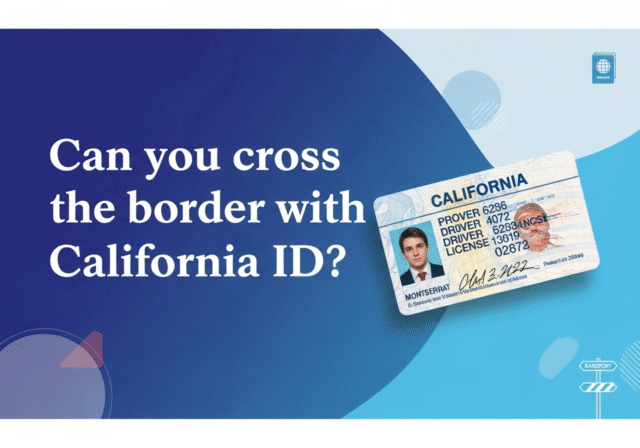Crossing international borders requires proper documents. Many travelers in California often wonder if a state ID card alone is enough to enter Mexico or re-enter the United States.
The answer depends on the type of California ID, whether it is Real ID-compliant, and the specific border regulations in place. Rules are enforced by agencies like U.S. Customs and Border Protection (CBP), the Department of Homeland Security (DHS), and the Transportation Security Administration (TSA).
Travel requirements change often, so it is important to stay updated. In this article, you will learn when a California ID is valid for border crossing, the difference between Real ID and standard IDs, alternative documents you may need, and helpful tips for smoother travel.
Understanding California IDs and Real ID Compliance
California issues two types of identification cards: standard state ID and Real ID. The Real ID Act was passed by Congress in 2005 to establish higher security standards for state-issued IDs. Real ID-compliant cards feature a gold bear and star in the upper right corner. Standard IDs, without the star, are not compliant with Real ID requirements.
Real ID will be required for boarding domestic flights and entering secure federal facilities beginning May 7, 2025. However, Real ID alone does not function as a passport or border-crossing document for international travel. This distinction is crucial because many travelers assume Real ID cards can replace passports, but that is not the case when crossing the U.S.–Mexico or U.S.–Canada borders.
Can You Cross into Mexico with Just a California ID?
If you are a U.S. citizen, you cannot use only a California ID, whether standard or Real ID, to cross the border into Mexico by land, air, or sea. Mexican authorities require a valid passport book or passport card for entry. The California ID is acceptable as a secondary form of identification but not as a primary travel document.
When entering Mexico by land, travelers must present proof of citizenship such as a passport. For short visits within the border zone, Mexican authorities may be less strict, but officially, a California ID alone does not satisfy entry requirements. If you plan to fly into Mexico, a passport book is mandatory, as airlines require it for international flights.
Can You Re-enter the U.S. with Only a California ID?
Re-entry into the United States requires proper documentation. A California ID alone is not enough. U.S. citizens must show a valid passport book, passport card, or another approved Western Hemisphere Travel Initiative (WHTI) document. Acceptable alternatives include:
- Passport book (required for air travel)
- Passport card (valid for land and sea entries)
- Trusted traveler cards such as SENTRI, NEXUS, or Global Entry
- Enhanced Driver’s Licenses (EDL), though California does not issue them
If you attempt to return from Mexico with only a California ID, U.S. Customs and Border Protection will not accept it as proof of citizenship. This can result in delays, secondary inspections, or being denied entry until your citizenship is confirmed.
Real ID vs. Passport: What’s the Difference?
Many travelers confuse Real ID with a passport. A Real ID is designed to meet federal security standards for domestic identification. It allows you to board flights within the U.S. and access federal buildings after May 2025. However, it is not valid for international travel. A passport, by contrast, is an internationally recognized document proving both citizenship and identity.
California’s Real ID is useful for domestic purposes but cannot replace a passport at international borders. If you plan to cross into Mexico or Canada, or fly abroad, you must carry a valid passport.
Border Crossing Requirements at San Diego and Tijuana
The San Ysidro and Otay Mesa ports of entry are the busiest land crossings between the United States and Mexico. Millions of travelers cross each year for business, tourism, and family visits. To cross smoothly, you must carry the correct documents. A California ID will not suffice on its own.
For pedestrians crossing into Tijuana, Mexican officials often request a passport. For drivers, a passport or passport card is required, along with a vehicle permit if traveling deeper into Mexico. Children also need proper identification, usually a passport, though in some cases a birth certificate is accepted for minors under 16 traveling by land.
The Role of Trusted Traveler Programs
For frequent border crossers, trusted traveler programs such as SENTRI, Global Entry, and NEXUS can save time. SENTRI (Secure Electronic Network for Travelers Rapid Inspection) is especially valuable for those who travel frequently between California and Mexico. Membership requires an application, background check, and interview, but it allows you to use dedicated lanes and reduces wait times.
While SENTRI cards can be used in place of a passport card at land crossings, a California ID cannot substitute for these programs. Trusted traveler cards are considered WHTI-compliant documents, making them valid for border entry.
Crossing with Minors Using California ID
When minors travel, different rules may apply. Children under 16 traveling by land or sea to Mexico or Canada can use a birth certificate, consular report of birth abroad, or naturalization certificate as proof of citizenship. A California ID alone is not sufficient. For air travel, all minors must carry a valid passport book regardless of age.
Parents should also carry notarized consent letters if the child is traveling without both legal guardians. This helps avoid issues at border checkpoints.
Risks of Relying Solely on California ID
Trying to cross with just a California ID can lead to significant travel problems. Risks include:
- Being denied entry into Mexico
- Being delayed or sent for additional inspection at U.S. re-entry
- Missing flights if airlines reject your documents
- Fines or penalties if caught without valid travel documents
To avoid these issues, always carry a passport when crossing an international border. The California ID should only serve as a supplementary form of identification.
Alternatives for Those Without Passports
If you do not have a passport, other WHTI-compliant documents may work for land or sea crossings. These include:
- U.S. passport card
- Trusted traveler program card (SENTRI, NEXUS, Global Entry)
- Enhanced Driver’s License (not issued in California, but available in some states like Michigan, Vermont, and Washington)
Unfortunately, California residents cannot obtain an Enhanced Driver’s License from their state. Therefore, the best option remains a passport book or card.
Border Crossing Tips for California Residents
To make your trip smoother, keep these tips in mind:
- Always carry a valid passport book or passport card for international crossings
- Use SENTRI or Global Entry if you cross frequently
- Check border wait times before traveling; many apps and websites track real-time updates
- Have your documents ready before arriving at the checkpoint
- For minors, carry birth certificates and parental consent letters if needed
The Future of Travel Documents and Real ID
Starting May 7, 2025, Real ID will become mandatory for domestic air travel. This means California residents who want to fly within the U.S. must hold a Real ID or use a valid passport. However, Real ID will not expand its role as an international travel document. The passport will remain the gold standard for crossing borders.
The U.S. government continues to encourage travelers to apply for passports well in advance, as processing delays can take several months. Relying on a California ID, even a Real ID, will never replace the need for a passport for border crossings.
Final Thoughts
A California ID alone is not enough to cross the U.S.–Mexico border. Whether it is standard or Real ID-compliant, it cannot substitute for a passport or other WHTI-approved document. To avoid complications, always carry the right identification. For California residents, the most reliable option remains the U.S. passport book or passport card.
International travel requires preparation, and the type of identification you carry determines how smooth your journey will be. A California ID is useful for domestic identification, but passports and trusted traveler cards remain essential for crossing international borders.














![Which Interval For The Graphed Function Contains The Local Maximum? [–1, 0] [1, 2] [2, 3] [3, 4]: Identifying The Local Maximum Which Interval For The Graphed Function Contains The Local Maximum [–1, 0] [1, 2] [2, 3] [3, 4] Identifying The Local Maximum](https://southslopenews.com/wp-content/uploads/2024/09/Which-Interval-For-The-Graphed-Function-Contains-The-Local-Maximum-–1-0-1-2-2-3-3-4-Identifying-The-Local-Maximum-100x75.jpg)